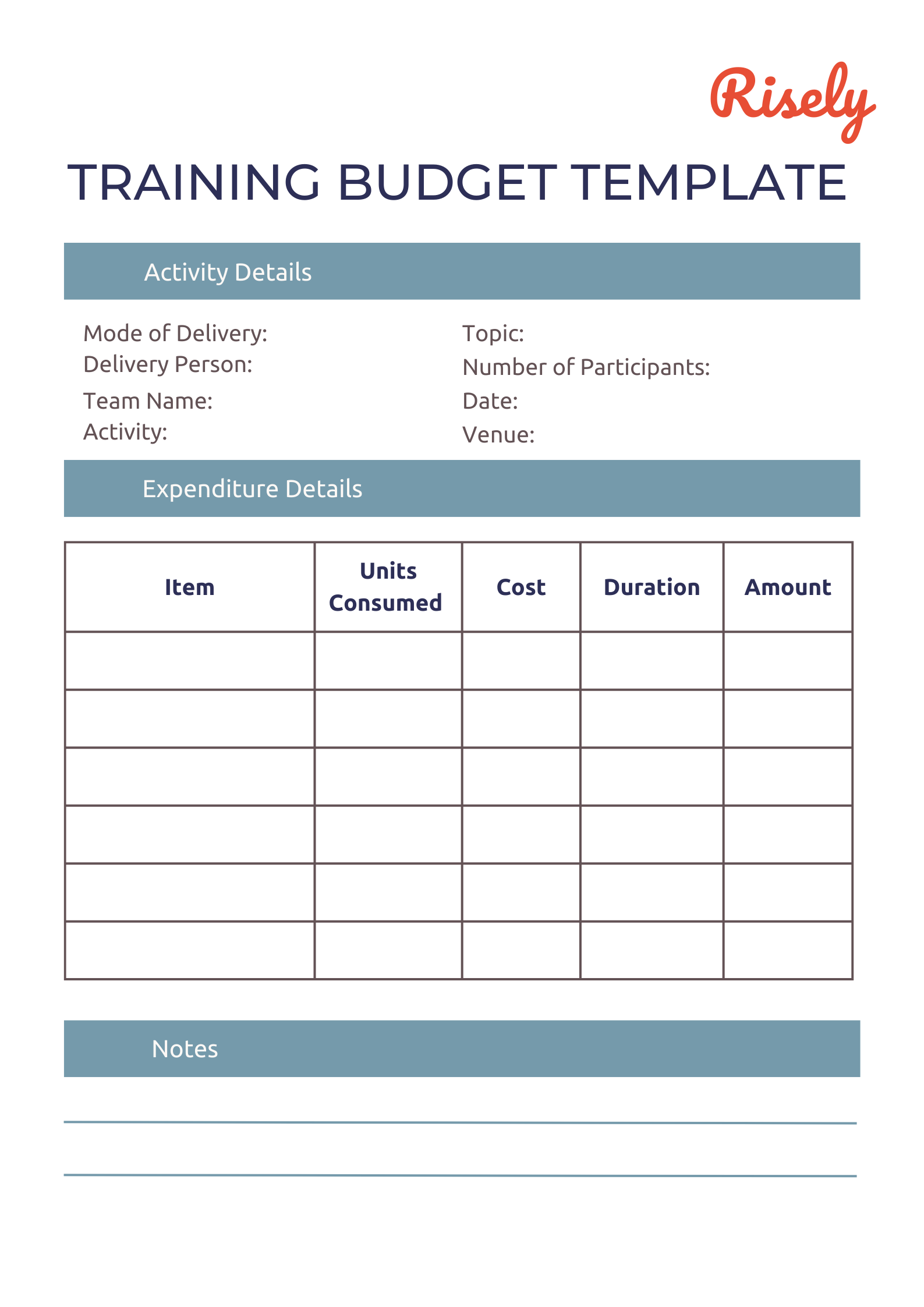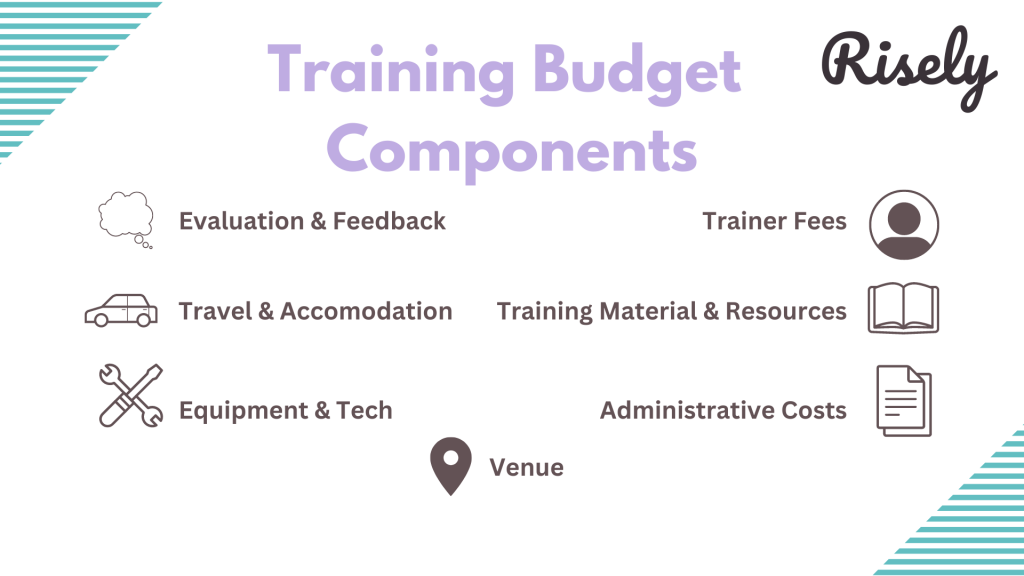How to Create Effective Training Budgets? Free Template
Are you looking to optimize your Learning and Development (L&D) training budget? This blog will dive into training budgets and explore how to maximize your resources. We’ll start by understanding a training budget and provide you with a practical example and template to get prompted. You’ll discover the benefits of adequate L&D training budgets and learn about the factors to consider when calculating your budget. We’ll also share strategies to create a comprehensive training budget, including defining objectives, conducting surveys, analyzing different scenarios, and calculating ROI. Additionally, we’ll discuss the components included in a training budget and provide insights on average training expenses in companies. If you’re looking for cost-effective training solutions, we’ll introduce you to Risely, an option worth considering. Get ready to maximize your L&D investment!- How to Create Effective Training Budgets? Free Template
- What is a training budget?
- Benefits of effective L&D training budgets
- Factors to consider when calculating the training budget
- How to create a comprehensive training budget?
- Training Budget Free Template
- Calculating the ROI of training initiatives
- Components included in a training budget
- Conclusion
- Training Budget FAQs
- Other Related Blogs
What is a training budget?
A training budget is a predetermined sum of money that an organization sets aside for the purpose of employee training and development. It allows for proper planning and allocation of resources towards various training initiatives, such as courses, workshops, materials, trainers, software, and related expenses. A training budget ensures employees have the necessary skills and knowledge to perform their jobs effectively and support their professional growth and development. By investing in employee training, companies can enhance productivity, improve performance, increase employee engagement and satisfaction, and ultimately contribute to the organization’s overall success. Read more: How to Develop a Training Program for Employees (+ Improvement Tips)Benefits of effective L&D training budgets
Investing in training budgets comes with numerous benefits for organizations and their workforce. One of the key advantages is improved employee performance and productivity. Employees who receive the necessary training and development opportunities enhance their skills, resulting in higher work output. Moreover, a well-planned training budget increases employee engagement and job satisfaction. Teams are committed to their growth and success by investing in employee development, increasing employee satisfaction and loyalty. Additionally, comprehensive training budgets aid in retaining top talent. Employees are more likely to stay with organizations that invest in their growth and development, creating a positive work environment. Furthermore, a well-managed training budget ensures the result of a skilled and knowledgeable workforce. By identifying and addressing training needs, organizations can equip employees with the necessary skills to excel in their roles and contribute to the team’s overall success. Read more about skill gap analysis, an effective tool to identify training needs here: 8 Easy Steps to do a Skills Gap Analysis for your TeamFactors to consider when calculating the training budget
There are several factors to consider when calculating a training budget. These include:- Training objectives: Determine the specific goals and outcomes you want to achieve through the training program. It will help you determine the level of investment required.
- Number of employees: Consider the number of employees participating in the training program. The more employees involved, the higher the cost may be.
- Training methods: Different training methods have different prices. For example, in-person training sessions may require travel and accommodation expenses, while online or virtual training may have licensing or subscription fees.
- Training materials and resources: Consider the cost of any training materials or resources needed for the training program, such as books, software, or equipment.
- Trainer fees: If external trainers or consultants are hired, factor in their payments or hourly rates.
- Time commitment: Consider how much time employees must devote to the training program and calculate potential productivity losses.
- Evaluation and follow-up: Budget for any training evaluation measures or follow-up activities that may be necessary to assess the effectiveness of the training program.
Other Interesting Reads
How to create a comprehensive training budget?
Creating a comprehensive training budget involves several strategies that can help optimize your L&D investments. L&D managers can allocate funds by assessing your organization’s training needs and prioritizing them based on importance and impact. Consider investing in cost-effective online training platforms or resources that provide valuable learning experiences. Continuous monitoring and adjustment of your training budget based on evolving business needs and employee development goals maximize your return on investment (ROI). By carefully planning and budgeting, L&D managers can create a skilled and knowledgeable workforce while driving employee engagement, retention, and satisfaction. Read more here: Understand The Value Of Training To Encourage Learning: With 7 BenefitsDefining objectives for the training budget
To effectively define objectives for your training budget, it’s crucial to assess your organization’s specific needs which learning and development can meet. Conduct a comprehensive training needs analysis to identify areas that require improvement and prioritize them accordingly. It will help you allocate your budget to high-priority training programs that significantly impact business outcomes and employee development. Consider the type of training required, such as instructor-led sessions, online courses, or a combination. Each method may have different cost implications, so choose wisely based on your budget constraints and the needs of your workforce. Additionally, explore cost-effective alternatives such as utilizing internal trainers or leveraging existing resources and materials to reduce external training costs without compromising quality. Evaluate the return on investment (ROI) of previous training initiatives to identify areas where you can optimize spending and maximize the value of your training budget. L&D managers can free up resources for more impactful training that drives employee engagement, productivity, and overall organizational success by eliminating redundant or ineffective programs.Conducting surveys to gather valuable data
Gathering valuable data through surveys is crucial for shaping your training budget. It provides insights into your workforce’s training needs and preferences, allowing you to make informed decisions. By analyzing survey data, you can identify and prioritize common training needs based on importance and performance impact. Surveys also help allocate a budget for mandatory or compliance-related training, ensuring legal requirements are met. Furthermore, conducting surveys enables you to explore cost-effective training solutions, like technology-based platforms or external providers offering group discounts. Implementing surveys is a strategic approach to creating a well-rounded training budget that maximizes outcomes and minimizes costs. Read more: The Complete Guide to Training Evaluation Survey (With 20+ Questions)HR budget preparation based on collected data
When preparing the HR budget based on collected data, it is essential to follow a systematic approach. Begin by gathering data on training needs and priorities within your organization from sources like surveys and interviews. It will provide valuable insights into the areas that require training. Once you have identified the training needs, assess the available budget for L&D training. Consider the most cost-effective delivery methods to optimize your resources, such as online courses or in-house workshops. Allocate funds based on the estimated costs of each training initiative, including materials, facilitator fees, and any necessary travel expenses. Monitoring and evaluating the effectiveness of the training programs is crucial to ensure they deliver value for the allocated budget.Analyzing different training scenarios
When creating a comprehensive training budget, it is crucial to analyze different training scenarios. By assessing the specific training needs of your organization and prioritizing them based on importance and impact, you can make informed decisions about where to allocate your training budget effectively. Evaluating the different training methods available, such as in-person workshops, online courses, or on-the-job training, can help you determine the best approach for your workforce while considering associated costs. Outsourcing training versus developing it in-house is also an essential consideration for maximizing the value of your budget. Regularly reviewing and adjusting your training budget based on the effectiveness and outcomes of previous initiatives ensures that your training program continues to evolve and meet your organization’s goals and objectives.Conducting thorough training research
To conduct thorough training research, it is essential to thoroughly investigate and analyze the specific training needs of your organization. Begin by identifying your workforce’s skills and knowledge gaps, prioritizing areas that require immediate attention. Thoroughly research different training needs of the team members. Consider the long-term impact of the chosen training programs, ensuring they provide lasting benefits to employees’ professional development. Remember to factor in additional costs such as travel expenses, materials, and equipment needed for the training sessions. Allocate your budget based on the research findings, ensuring sufficient funds are allocated to address critical skill gaps and meet the needs of your workforce.Training Budget Free Template
Now that we know all the components and essentials of an organization’s training budget let’s put it together. In general, your framework for the training budget should allow you to see the big picture at a glance—showing where the money goes, why, and what results you can expect in return. With this idea in mind, we have created a free printable training budget template for teams that you can download and use.
Calculating the ROI of training initiatives
Calculating the return on investment (ROI) of training initiatives can help you determine the effectiveness and value of your training programs. Here’s a simple formula you can use:ROI = (Training Benefits – Training Costs) / Training Costs x 100
Components included in a training budget
The components of a training budget typically include the following:- Training materials and resources: This includes the cost of purchasing or developing training materials such as textbooks, workbooks, online courses, and software.
- Trainer fees: If you use external trainers or consultants to deliver training sessions, their fees would be part of the budget.
- Travel and accommodation: If employees need to travel for training, the budget should include transportation costs and hotel accommodations.
- Venue rental: If you are hosting training sessions at an external location, there may be costs associated with renting the venue.
- Equipment and technology: This includes any equipment or technology needed for training, such as laptops, projectors, or virtual meeting software.
- Administrative cost: Administrative costs include any expenses related to organizing and coordinating the training program, such as printing materials or postage fees.
- Evaluation and feedback: It is essential to allocate a budget for evaluating the effectiveness of the training program through surveys or assessments to gather participant feedback.

Conclusion
In conclusion, maximizing your L&D training budget is crucial for the growth and development of your employees and, ultimately, your organization. By carefully planning and strategizing, you can ensure that every dollar spent on training delivers a positive return on investment. Whether defining clear objectives, conducting surveys to gather data, or analyzing different training scenarios, taking a comprehensive approach to your training budget will yield the best results. And if you’re looking for a cost-effective training solution that offers a wide range of corporate training programs, consider partnering with Risely. With our expertise and customizable options, we can help you make the most of your L&D training initiatives.Plan L&D effectively with a free template from Risely!
Grab your free copy of L&D strategy framework by Risely and get started.
Training Budget FAQs
What are the elements of a good training budget?
The elements of a good training budget include identifying specific training needs, setting clear objectives and goals, allocating sufficient resources for training activities, considering the cost of trainers or external programs, evaluating the effectiveness of training, and adjusting the budget as needed.
Why is training and development budget important?
The training and development budget is important because it allows organizations to invest in the growth and skill enhancement of their employees. It helps improve employee performance, increase job satisfaction, enhance productivity, foster innovation, and maintain a competitive edge in the market.
How do you create an employee training plan?
To create an employee training plan, start by identifying the skills and knowledge gaps within your workforce. Set clear training objectives, determine the most effective training methods (e.g., workshops, online courses), establish a timeline, assign responsibilities, and track progress. Regularly evaluate and adjust the plan to ensure its effectiveness.
What is the cost of training?
The cost of training can vary significantly depending on factors such as the type of training (e.g., in-house vs. external programs, classroom vs. online), the duration and complexity of the training, the number of employees being trained, and any additional expenses (e.g., materials, travel). It is important to consider both direct costs (e.g., registration fees) and indirect costs (e.g., employee time away from work) when estimating training costs.
Other Related Blogs
How to ask for help as a manager?
How to ask for help as a manager? I am more than sure that at some point, you needed help and held back because of one thought: “What if they…
7 Top Learning And Development Newsletters For 2025
7 Top Learning And Development Newsletters For 2025 Newsletters are among the most popular mediums for catching up with the world today. After all, what’s not to like – you…
Are you a supportive manager?
Are you a supportive manager? Do you consider yourself to be a supportive manager? Being supportive as a manager is not a new idea. In fact, I have been hearing…
Top 8 ways to make the best use of an Employee Assistance Program
Top 8 ways to make the best use of an Employee Assistance Program A happy workplace is a productive workplace. But, with the daily pressures of work, it’s easy for…


